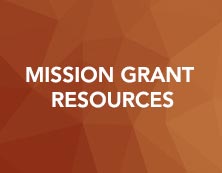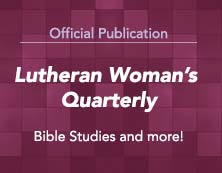Introduction
The opportunity to serve as President is an expression of confidence in your abilities and your dedication to the Lord. Since it is His work, you will want to do the very best you can.
Begin with:
- prayer, asking God for His guidance and presence so that all you do is to His glory;
- awareness of what it means to be a servant leader;
- knowledge of the LWML – its purpose, structure, bylaws, and guidelines on the group, zone, district, and national levels;
- examination of your specific responsibilities as president of your organization;
- a working knowledge of basic parliamentary procedure, so that the business of the LWML may be handled effectively, fairly, and efficiently;
- a review of the materials and files you received from the former president.
Purpose of the President
The primary purpose of the president is to:
- preside at all meetings of the organization and its executive committee;
- appoint specified committees and any other committees deemed necessary;
- be an ex-officio member of all committees except the nominating committee;
- perform whatever additional duties the organization may prescribe.
Additional responsibilities may include:
- be responsible for and involved in planning for the organization;
- prepare meeting agendas, and include opportunities for community building;
- serve as the official spokesman for the organization or appoint an officer to do so, but approve all public statements;
- attend LWML meetings, events/rallies, etc., and encourage others to attend;
- provide for the distribution of LWML publications;
- ensure your fellow officers have the materials and information needed to perform their duties such as files, LWML Handbook, officer guidelines, and contact information for officers at various levels, as needed;
- see that general duties are written for each office of your specific organization;
- arrange for orderly and complete transfer of materials from outgoing to incoming officers, along with any information that would make their work easier.
Leadership
We have different gifts, according to the grace given us, … if it is leadership, let him govern diligently …
(Romans 12:6-8 NIV)
A Christian leader:
- is a servant leader;
- values people and is sensitive to their needs;
- knows and clearly expresses the vision and purpose of the organization;
- assists the group in reaching decisions;
- helps the organization accept change, when needed;
- encourages individuals to maintain good relationships with others;
- offers opportunities and encourages each member to contribute in meaningful service;
- identifies and mentors future servant leaders.
Implementation of Possible Change
A leader often comes to office with some new ideas she would like the organization to consider. Because people may be reluctant to change, she may:
- carefully consider her proposal and be aware of who is affected and to what extent;
- give a clear explanation of the purpose for the change;
- create a climate of trust that allows people to discuss the topic and to express their views freely;
- help the organization to determine the change process, if change is adopted;
- graciously accept the organization’s decision, even when it is opposite the leader’s view.
Motivation
Motivation comes from a Latin word meaning “to move.” It is important to know that motivation comes from within. Motivating others requires genuine concern for people and their needs – physical, spiritual, emotional, developmental. A leader interested in motivating others should ask things such as:
- Do we need to provide nursery care for mothers of young children or transportation for older members who no longer drive at night?
- Do we accept each member in Christian love and give her ideas a fair hearing?
- Do we allow each member to share in the plans we make so that she can feel a sense of responsibility and involvement, and then thank her for her contribution?
- Do we offer our members challenges within the scope of their abilities or opportunities to use their special talents and skills?
Christ’s love, our source of motivation, gives us the power to enrich the experiences and well-being of all with whom we come in contact.
Planning
Planning is an on-going effort to provide guidance and direction in the use of available resources for the effective pursuit of an organization’s purpose. The following planning method is designed to help each LWML group focus its efforts and effectively use its resources. The process includes:
- Develop a purpose (mission) statement. A purpose statement is a clear, concise statement of the reason or purpose for the existence and efforts of your organization. Begin by knowing and understanding the LWML Mission Statement and your organization’s mission statement.
Sample purpose statement
The purpose of St. Timothy LWML is to assist each woman of the congregation in affirming her relationship with Christ so that she is enabled to use her gifts in ministry to the people in her congregation and community.
- Identify the primary targets. A primary target is a group of people or an area of effort that your organization must significantly impact in order to effectively pursue its purpose.
Sample primary targets
Mentoring people in need, personal spirituality, mite giving
- Write a goal statement for each primary target. The statement describes the preferred future condition of what is expected to happen to the primary target (the group of people or area of effort) so that the organization is fulfilling its purpose.
Sample goal statement for the primary target “mite giving”
All women of the congregation are aware of the purpose of the Mite Box and eagerly participate in praying for missions and giving mites.
- Select activities. Activities are the specific efforts or endeavors of assigned individuals with a given period of time to accomplish a goal. Consulting the LWML Catalog, the LWML Web site, and other resources may be very helpful at this point in the planning process.
Sample activities for the goal statement above
Assign a district LWML or LWML mission grant to each woman of the congregation for which prayer is requested; request the congregation to designate a Sunday-of-the-month for mite offering; have special mission focus directed toward one or more of the LWML and/or district LWML mission grants.
- Complete an evaluation. Regularly evaluate your activities to see if they are helping the organization use the gifts and energies of the people to accomplish the purpose statement.
Planning is work, meaningful work. If planning help is needed, assistance is available from the LWML Growth and Development Committee at depor@lwml.org.
Committees
Much of the work of an organization is done through committees. How successfully the committee operates may determine the success of the organization. For more effective committees, attempt to:
- appoint members who have a real interest in or talent for the committee assignment;
- choose people who can work well together;
- be alert to the abilities of new members or those who have not served before as a committee appointment may be the way to get them involved in organization activities;
- give the chairman and other members clear instructions about what they are to do and by what date;
- tell the chairman what kind of progress reports are required and when they are to be made;
- let the committee members know that the responsibility is theirs and let them take over.
Meetings
A worthwhile meeting results from thorough planning and organizing on the part of the leaders. You’ll want members to be interested, involved, and willing to come again!
Plan the Program
If effective planning is followed, the program will be designed to fill a need or interest expressed by the members, assuring that the subject will be of interest to them. In most organizations the program chairman has the responsibility for this portion of the meeting. Strive for variety in your format – doing the usual in an unusual way.
Make an Agenda
Taking care of the business of the organization is important, but it should be handled efficiently. This can be done when the president prepares an agenda. For further help, see the excerpt from Parliamentary Basics for Everyone, at the conclusion of this guideline.
A president should
- prepare the agenda several days before the meeting so that she will be able to alert people to their expected report at the meeting and to the time allowed for reports as well as obtain special information the group might need to make decisions, etc.;
- ask the secretary to check the minutes of the last meeting for items of unfinished business;
- keep the agenda as short as possible – not cluttered with items that could be handled by a committee or the executive committee but remembering to bring before the group matters that deserve their full consideration;
- handle routine matters quickly and efficiently to allow sufficient time for discussion of important matters;
- give information to members before the meeting when an agenda item may take considerable discussion, so that they will have time to review it;
Before the meeting
- arrive early and check physical arrangements such as seating, lighting, ventilation, coffee breaks, visual aids, and materials for distribution;
- check the little things one last time and make discreet changes quickly;
During the Meeting
- begin at the announced time, even if only a few are present as doing otherwise punishes the prompt and rewards the latecomers;
- introduce guests and program participants as everyone may not know each other;
- preview the meeting format, items of business to be discussed, and projected time of adjournment;
- follow the agenda as closely as possible with the goal of trying to keep things moving ahead without abruptly cutting off necessary and meaningful discussion;
- close the meeting on time.
Soon After the Meeting
- thank the guests and members who assisted in the program with a phone call or written note a few days later;
- evaluate the meeting, considering what worked well and what might be changed next time;
- follow through on the decisions made, taking the necessary action to implement them, remembering that the ultimate proof of a successful meeting is what happens afterward.
Everything you say or do should be done in the name of the Lord Jesus, giving thanks to God the Father through him (Colossians 3:17 GOD’S WORD).
Commit to the Lord whatever you do, and your plans will succeed (Proverbs 16:3 NIV).
Being confident of this very thing, that he which hath begun a good work in you will perform it until the day of Jesus Christ (Philippians 1:6 KJV).
Parliamentary Tips: Writing a Basic Script Agenda
(Taken from Parliamentary Basics for Everyone)
It is a good idea for the president to prepare a basic script agenda in advance of the meeting. This written outline or order of business helps the president to take up each item in a logical sequence. Then as the meeting progresses, she can note what action was taken. In preparing the agenda she will review the minutes of the previous meeting with the secretary and consult with other officers who intend to introduce new business.
It is also the duty of the president to determine whether a quorum is present. The quorum is the minimum number of voting members who must be present in order to transact business legally. A group’s bylaws should establish the quorum. If not, the quorum is a majority of the membership.
1. Call to Order
(One tap of the gavel) “The meeting will please come to order.”
At this time the president welcomes guests and introduces them to the assembly.
2. Opening Devotion and/or Bible Study
3. Roll Call (Optional)
4. Reading an Approval of Minutes
“The secretary will read the minutes of the last (or September, etc.) meeting.” (Secretary stands and reads.) “Are there any corrections to the minutes? (Pause) “If not, they stand approved as read.” If there are corrections, they are usually accepted by general consent, and the president then declares, “The minutes stand approved as corrected.”
The reading of the minutes may be dispensed with at this time, but they must be read and approved at some point. The minutes may be approved by a pre-appointed committee, or they may be printed and distributed to the membership prior to the meeting, where they would be considered for approval.
At this point the president may ask the secretary to read any correspondence. The reading of the correspondence that requires assembly action may be delayed until a more appropriate time on the agenda.
5. Financial Statement
“We will now have the treasurer’s report.” or “The treasurer will give the financial statement.” (Treasurer stands and reads. The treasurer need only state the beginning balance, the receipts, the disbursements, and the ending balance.) “Are there any questions for the treasurer?” (Pause) “The report will be filed.”
Her report is not “filed for financial review.” It should not be “accepted,” “adopted,” or “approved.” No action is taken on the treasurer’s report. At the end of the fiscal year, the treasurer’s books are presented for financial review, and that report is adopted. This releases the treasurer from further responsibility.
6. Reports of Other Officers, Boards, and Standing Committees
The officers, boards, and standing committee chairmen report in the order they are listed in the bylaws, the president reporting first. Often the group bylaws will prescribe whether reports are required at each meeting or annually.
7. Report of Special Committees
Special Committees report in the order that they were appointed.
8. Special Orders
Matters that the bylaws require to be considered at a particular meeting, such as election of officers, may be addressed here on the agenda.
9. Unfinished Business and General Orders
Items considered in this category are drawn from the minutes and introduced by the president. Unfinished business is business brought from a previous meeting because adjournment occurred before the agenda was completed. General orders are items that were postponed to the present meeting for action.
10. New Business
“Is there any new business?” The president introduces new items of business requiring action. Members may also make motions as long as no other question is pending. The President may ask, “Is there any further new business?”
Sometimes the question arises as to whether an item is new business or unfinished business. If a subject has been mentioned at the last meeting and there is an informal understanding that it will be discussed at the next meeting, it should be brought to the floor here as new business.
11. Announcements (Placed here or after the program)
The president reads from a prepared list and then asks, “Are there further announcements?”
12. Adjournment
There may be a formal motion to adjourn but it is not required. The president may ask, “Is there any further business?” (Pause) “Since there is no further business, the meeting is adjourned.” (one tap of the gavel)
13. Closing Prayer/Hymn









